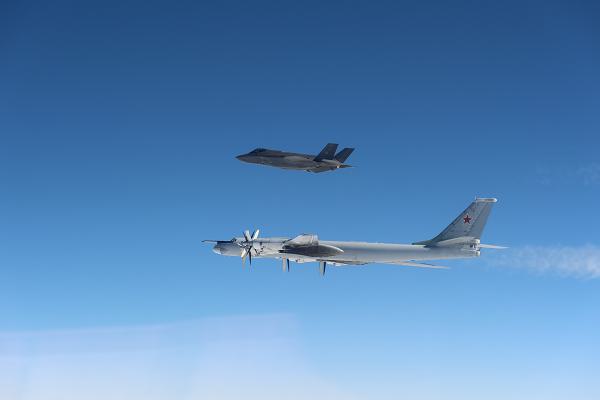
Bering Sea. (May 1, 2025): In this Defense Department photo, a U.S. Air Force F-35 Lightning II intercepts a Russian Tu-95 “Bear” strategic bomber in the skies near Alaska. Multiple F-35s were launched to intercept and monitor the Russian aircraft, which remained in international airspace roughly 250 nautical miles from Shemya Island in the western Aleutians. The North American Aerospace Defense Command (NORAD) noted that while this type of Russian activity within the Alaskan Air Defense Identification Zone is routine and not viewed as a threat, it is continuously monitored to safeguard the security of North America. The Tu-95 “Bear” is a four-engine turboprop-powered strategic bomber and missile platform that entered service in1952
This flyby by the Russians comes less than three months after American and Canadian fighter jets were scrambled to shadow multiple Russian warplanes that were spotted in the Arctic. In this incident, the Russian Bear remained in international airspace and posed no immediate threat to U.S. forces, however the frequency of such encounters is concerning.
According to the NORAD, last September 23rd a Russian fighter was intercepted while flying close to an American aircraft off the coast of Alaska. At the time, a U.S. general said, "the conduct of one Russian Su-35 was unsafe, unprofessional, and endangered all." This close encounter with a Russian jet comes just weeks after eight Russian military planes and four of its navy vessels, including two submarines, came close to Alaska as China and Russia conducted joint drills. This triggered the deployment of about 130 U.S. soldiers who were sent to Shemya Island, about 1,200 miles southwest of Anchorage.
While the Russian planes remained in international air space, they entered a region beyond U.S. and Canadian sovereign air space called the Air Defense Identification Zone (ADIZ), where aircraft are expected to identify themselves. The ADIZ is a stretch of international air space bordering the sovereign space around the U.S. and Canada, which both countries monitor to detect all aircraft passing through.


